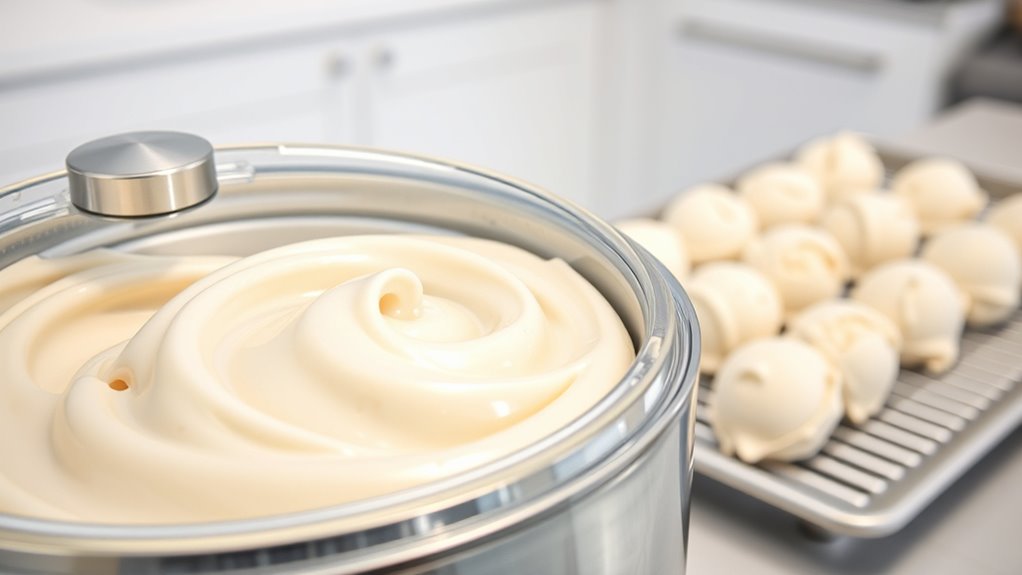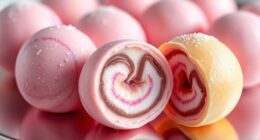To perfect every ice cream batch, focus on creating a balanced base with fresh ingredients and proper proportions of cream, milk, and eggs. Chill the mixture thoroughly to meld flavors and improve texture. Maintain consistent freezer temperatures and churning speeds to guarantee smoothness and avoid ice crystals. Use calibrated equipment and precise measurements. Address issues like overly icy or soft results by adjusting stabilizers and ingredients. Keep going to open more tips for flawless ice cream every time.
Key Takeaways
- Use high-quality, fresh ingredients and measure precisely for consistent flavor and texture.
- Properly chill and rest the base mixture to develop flavors and improve churning results.
- Maintain stable freezer temperature and churning times to ensure smooth, evenly frozen ice cream.
- Regularly calibrate equipment and employ accurate tools for precise control over process variables.
- Troubleshoot ingredient substitutions and infusion techniques to prevent texture issues and flavor inconsistencies.
Perfecting Your Base Mixture for Ice Cream
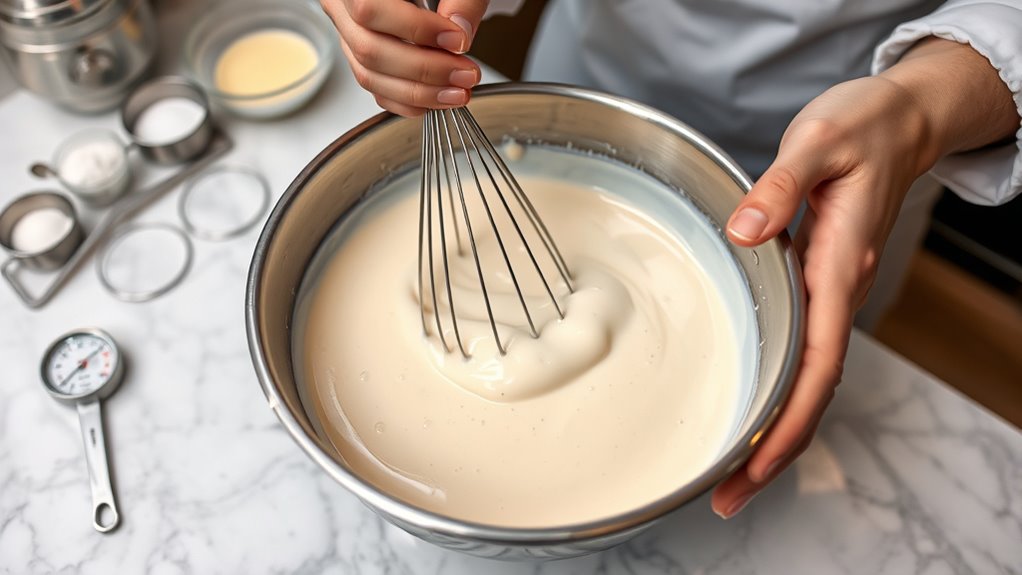
To create a smooth, creamy ice cream, you need a well-balanced base mixture. Focus on flavor balancing by adjusting sweetness, fat, and dairy content to suit your taste. Carefully sourcing ingredients is essential—use fresh, high-quality dairy, eggs, and flavorings to guarantee consistent results. Proper ingredient sourcing not only impacts flavor but also affects texture and stability. Incorporate a blend of sugar and stabilizers to prevent ice crystal formation, creating a creamy mouthfeel. Pay attention to the proportions of cream, milk, and eggs to achieve the right richness without overpowering the flavor. A well-constructed base forms the foundation of every successful batch, so take the time to measure precisely and select quality ingredients for the best possible outcome.
Mastering Proper Chilling and Resting Techniques
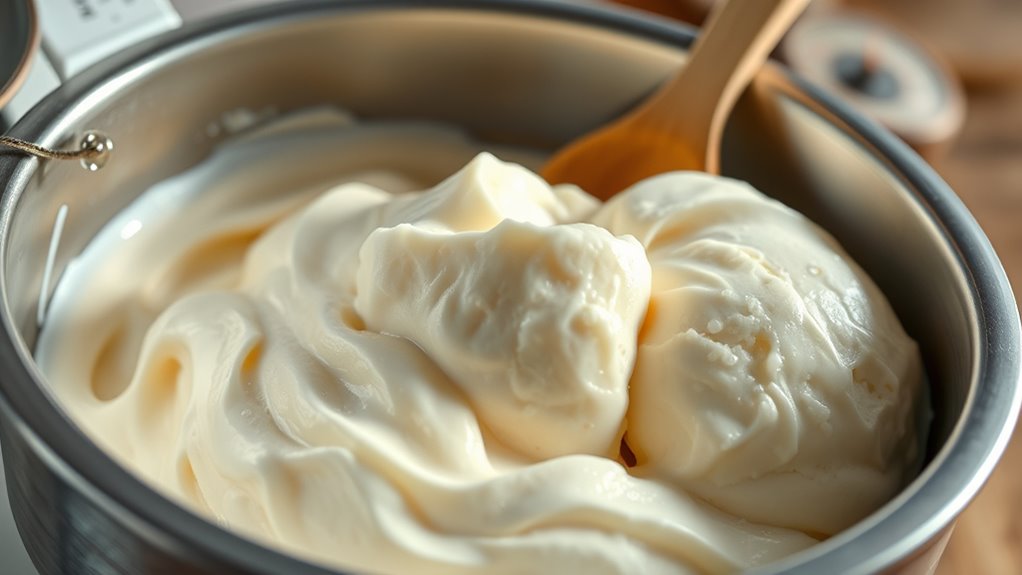
Chilling and resting your ice cream base properly are essential steps that can make or break your final texture. During this phase, your goal is to allow flavors to meld smoothly and ensure a consistent, creamy result. Use proper mixing techniques to incorporate ingredients thoroughly without introducing air or disrupting the mixture’s balance. Resting the base in the refrigerator for at least 4 hours—or overnight—helps flavors to develop and stabilizes the mixture’s temperature. This step also improves texture, making churning easier and more uniform. Pay attention to flavor balancing during chilling; if your base tastes off before freezing, it will carry over into the final product. Mastering these techniques guarantees a smoother, richer, and more consistent ice cream every time.
Ensuring Consistent Freezing and Churning Processes

Achieving consistent freezing and churning results depends on maintaining steady conditions throughout the process. To do this, focus on:
- Temperature Stability: Keep your freezer at the right chill level to preserve ingredient freshness and prevent ice crystal formation that can affect flavor balance. Proper calibration of your freezer’s temperature controls helps maintain optimal conditions. Consistent temperature control also supports the quality of ingredients, ensuring each batch has the desired texture and flavor.
- Churning Speed: Maintain a consistent churning pace to ensure smooth texture and even freezing, which helps lock in fresh flavors.
- Timing Precision: Avoid over-churning or under-churning by sticking to ideal time frames, ensuring ingredient freshness is preserved and the final product’s consistency is perfect.
Using the Right Equipment and Tools for Uniform Results
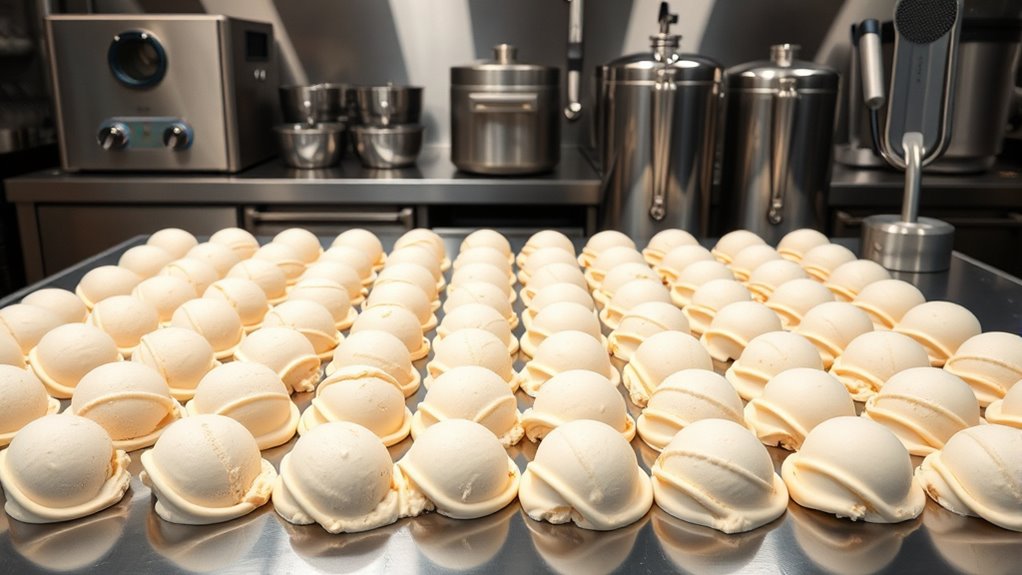
Choosing the right equipment and tools can make all the difference in producing a consistently smooth and well-textured ice cream. Make sure your equipment is properly calibrated; inaccurate temperature controls can affect texture and consistency. Use high-quality, fresh ingredients to achieve a uniform flavor and texture in every batch. A reliable ice cream maker with precise speed and temperature settings helps maintain consistency, so regularly check and calibrate it. Invest in quality mixing bowls, spatulas, and thermometers to measure and blend ingredients accurately. Properly calibrated equipment minimizes fluctuations that can lead to inconsistent results. Additionally, the integration of AI-powered monitoring systems can provide real-time feedback for optimal performance and consistency in kitchen appliances. Regularly cleaning and maintaining your equipment also ensures optimal performance and consistent results. Proper equipment maintenance and calibration are essential for perfect ice cream every time. Moreover, understanding the role of temperature control in the freezing process can significantly enhance your ability to achieve uniform results.
Troubleshooting Common Inconsistencies in Ice Cream Making

Even with careful preparation, you might encounter common issues that affect your ice cream’s texture and flavor. To troubleshoot, consider these key factors:
Even with careful prep, common issues can impact your ice cream’s texture and flavor—troubleshoot these key factors.
- Ingredient substitutions – Using different dairy or sweeteners can alter creaminess or sweetness. Stick to recipe ratios or adjust carefully. For example, substituting lower-quality ingredients may affect the overall ice cream quality, leading to less desirable results.
- Flavor infusions – Overly aggressive infusions can cause bitterness or uneven flavor. Infuse gently and strain thoroughly.
- Texture inconsistencies – If your ice cream is icy or soft, check your churning time, or consider adding stabilizers.
- Proper ingredients – Ensuring the use of quality and appropriate ingredients helps maintain desired texture and flavor. Understanding the role of ingredients like stabilizers and emulsifiers can help you achieve a smoother, more consistent texture.
Frequently Asked Questions
How Does Ingredient Quality Affect Ice Cream Consistency?
You need to know that ingredient quality directly impacts ice cream consistency. When you source ingredients carefully, you guarantee better flavor and smoother texture. Poor-quality ingredients can cause variations in flavor and texture, making it hard to achieve reliable results. By prioritizing ingredient sourcing, you maintain flavor consistency, ensuring each batch tastes just as good as the last. High-quality ingredients help you produce ice cream that’s consistently delicious and appealing.
What Role Does Air Incorporation Play in Texture?
Think of air incorporation as the heartbeat of your ice cream’s texture. When you whip in air bubbles, you create a light, fluffy foam that melts smoothly on the tongue. Proper foam stability keeps these bubbles intact, preventing ice crystals from forming and ensuring a creamy consistency. Without enough air or unstable foam, your ice cream feels dense or icy, so aim for a delicate balance that enhances its luscious mouthfeel.
How Can I Prevent Ice Crystals From Forming?
To prevent ice crystals from forming, you should focus on proper mixing and storage techniques. Regular churning keeps the texture smooth, contributing to texture improvement, while rapid freezing minimizes crystal growth. Use ingredients like alcohol or stabilizers to help enhance flavor and prevent crystallization. Additionally, storing ice cream at consistent, low temperatures prevents crystals from developing over time, ensuring your ice cream stays creamy, flavorful, and irresistibly smooth with every batch.
What’s the Ideal Storage Temperature for Finished Ice Cream?
You should store your finished ice cream at a temperature between -20°C and -18°C (around 0°F to 0°F). Maintaining proper storage conditions guarantees temperature stability, which prevents ice crystals from forming and keeps the texture smooth. Avoid frequent temperature fluctuations by keeping the freezer door closed as much as possible. Consistent storage conditions help preserve flavor, texture, and overall quality, making sure every scoop is just right.
How Do Batch Size Variations Impact Final Quality?
Batch size variations can impact your final ice cream quality by affecting flavor distribution consistency. When you make batch size adjustments, verify you scale ingredients proportionally to maintain texture and flavor balance. Larger batches may require longer mixing times for even flavor dispersion, while smaller batches demand precise measurement. By carefully managing batch size adjustments, you ensure each batch maintains the same high quality, delivering consistent taste and texture every time.
Conclusion
Remember, consistency is your secret weapon. For example, if you noticed your last batch was too icy, tweaking your churning time or chilling your mixture longer could make all the difference. Imagine perfect, creamy ice cream every time—like a pro! By mastering each step, from base to freeze, you’ll turn good batches into great ones. Keep experimenting, stay patient, and soon, flawless ice cream will be your signature treat.
